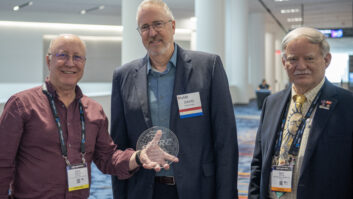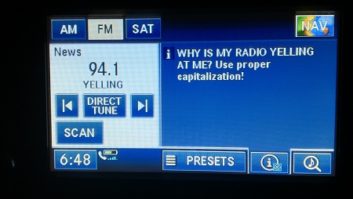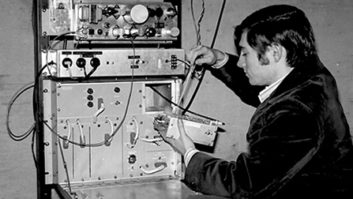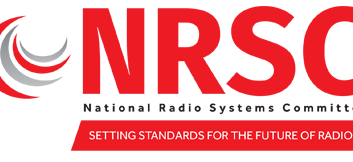
Members of the National Radio Systems Committee prepare to convene at the spring NAB Show. credit: Photo by Jim Peck Sometime soon, U.S. radio probably will ask the FCC to allow AM stations the option of using all-digital HD Radio. This will be contentious; everything about IBOC is. Yet allowing full digital has the potential to be exciting, not only for the moribund AM HD Radio franchise, but for AM broadcasters generally, who — despite challenges — are sitting on spectrum that, if empty, might be considered priceless in this era of “limited bandwidth, infinite demand.”
Expect the National Radio Systems Committee again to be at the center of industry discussion.
NRSC notes its 35th anniversary at the Radio Show. It was formed in 1979 by the National Association of Broadcasters and the Consumer Electronics Association, then called the Electronic Industries Association, to investigate and recommend improvements in AM and FM transmission and reception.
The committee “brings together companies from two sides of the air chain, from the transmit side and the receive side, to make sure they work together properly as time goes on,” said Mike Bergman, senior director of technology and standards for CEA. Members work for hardware manufacturers, consulting engineers, tech developers, broadcasters and others (I’ve posted the list at http://tinyurl.com/rwnrsc). NAB and CEA administer it, providing staff support.
Bergman’s involvement predates his CEA job; he was active for a decade while with Kenwood, mostly as co-chair of the digital radio subcommittee. His NAB counterpart is David Layer, senior director, advanced engineering, who has been involved since 1995. Both mentioned the level of expertise in the group. “They’re just such high-caliber people, to a person,” Layer said. “They’re smart and well-informed. And for a group of technologists, they’re incredibly business-savvy.”
NRSC has no official role at the FCC, but its opinion matters there, where technical resources are limited. When a bi-industry group agrees on a technical recommendation, FCC staff takes note.
Over 35 years, NRSC has published five standards, dealing with AM preemphasis/deemphasis and broadcast audio transmission bandwidth; emission limitations for AM broadcast transmission; the radio broadcast data system; and in-band, on-channel digital radio. They must be renewed or retired on a five-year cycle.
The committee has had three chairmen: Wally Johnson, Charlie Morgan and now Milford Smith, vice president of radio engineering for Greater Media. “I think right now the NRSC is as vital and relevant as it has ever been. It has as much or more going on than it ever has,” Smitty said.
In addition to standards, he continued, it publishes guidelines, “nuts and bolts” descriptions that engineers can use when launching, modifying and adding services, on nrscstandards.org.
I observed how readily NAB and CEA work together at this level while policy leaders sometimes are at loggerheads. Organizations may dispute certain issues like spectrum repacking; but “on NRSC we always seem to get along just fine,” Layer said. Bergman agreed: “We’ve been cooperating on broadcasting for more than 35 years. CEA was founded some 90 years ago as a radio standards organization; we have deep, deep roots in radio. The conflict areas make headlines [but] the cooperation is happening on a regular basis.”
(If you wonder whether members really get along, you’ll have to attend. We in trade media are excluded from its meetings. This policy should be overturned, at least for meetings that involve final votes, which should be on the record. But the question of press access has been explored here.)
So what next? Look for the RBDS Subcommittee to expand its guideline for creation and distribution of audio metadata. “Syndicated radio programs don’t usually provide metadata to the broadcasters, so we’re interested in trying to facilitate distribution,” Layer said.
RDS/RBDS may not seem sexy but Smitty thinks RDS, “this little, narrow, low-bitrate data service,” is a perfect example of why NRSC matters. “With all that’s gone on with traffic, title/artist, EAS — the reason those things are possible is because of standardization. Everyone knows how it works — that if you do ‘this’ on one end, ‘this’ is what will come out the other end. It’s one reason RDS has become such a valuable tool.”
The NRSC continues to explore FM stereo single-sideband suppressed carrier modulation for stereo audio generation, in conjunction with NPR Labs. Its AM and FM Analog Broadcasting Subcommittee meanwhile is looking to update guidelines for AM modulation-dependent carrier level control systems. “We would like to include more information about the use of MDCL with hybrid IBOC; we’re hoping to do some IBOC compatibility testing later this year,” Layer said. A current FCC proposal would allow stations to use MDCL without prior authorization.
But digital radio surely will remain the topic that generates the most attention and heat. NAB Labs has been leading tests of all-digital AM at a handful of stations. Once that wraps up, it’s reasonable to expect that NRSC will start an evaluation process. Says Layer, “There’s no definite timeline; but that’s what we did before.”
Presumably the FCC would then look to the NRSC for a report. Smitty said, “It’s unlikely the commission would routinely authorize something like all-digital AM without that evaluation.”
Another area NRSC could explore fruitfully is how radio content displays on mobile devices. Cellphones have their own peculiarities in display and reception, Bergman pointed out. Increasingly, audio content of one form or another is consumed and controlled through that interface; the interface matters more to radio now. Meanwhile readers are well aware of the importance of the dashboard interface to radio, and I wonder if NRSC might someday take a higher profile there.
Meantime, Bergman urged readers to visit the site “to make sure you are up to date on what the best engineers in radio today recommend you should be doing with your signal.” Layer encouraged engineers to become familiar with its document repository and said NRSC members can access resources via a helpful Kavi software platform. Smitty said the group wants more volunteers, particularly with a number of veterans having retired. One need not go to trade shows; important work is done at subgroup levels, usually by teleconference.
I asked Bergman, who also deals with standards such as Ultra HD and IPv6, whether the NRSC has been effective. “Absolutely,” he replied, and pointed to — gasp — HD Radio. “The NRSC played a role in getting this approved at a time when radio was looking for solutions, ways to maintain competitiveness, enhance itself and launch new features. You can’t drive through a major city today without seeing a billboard talking about their HD2 channels.”
But he said standards can only do so much. Tech developers, inventors, retailers, carriers and receiver/transmitter manufacturers must cooperate on a broader scale to ensure success. Meantime it’s wise to remember what NRSC does not try to do with technical matters. As Smitty put it: “Whether it’s a good idea isn’t our job. It’s our job to say yay or nay about the viability.”
On what topics should the NRSC focus future efforts? Comment on this or any story. Email [email protected].












